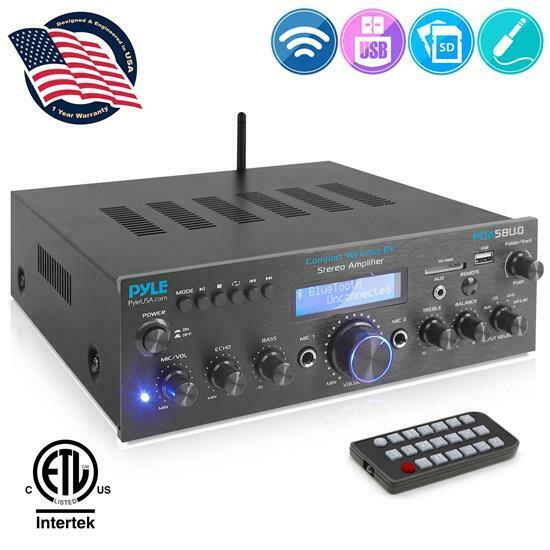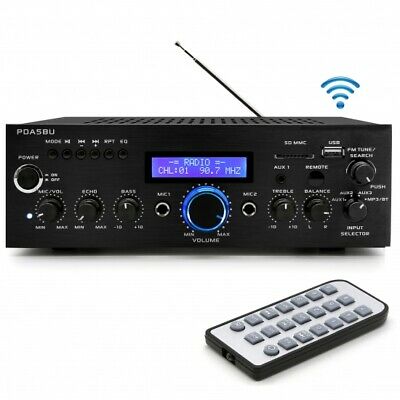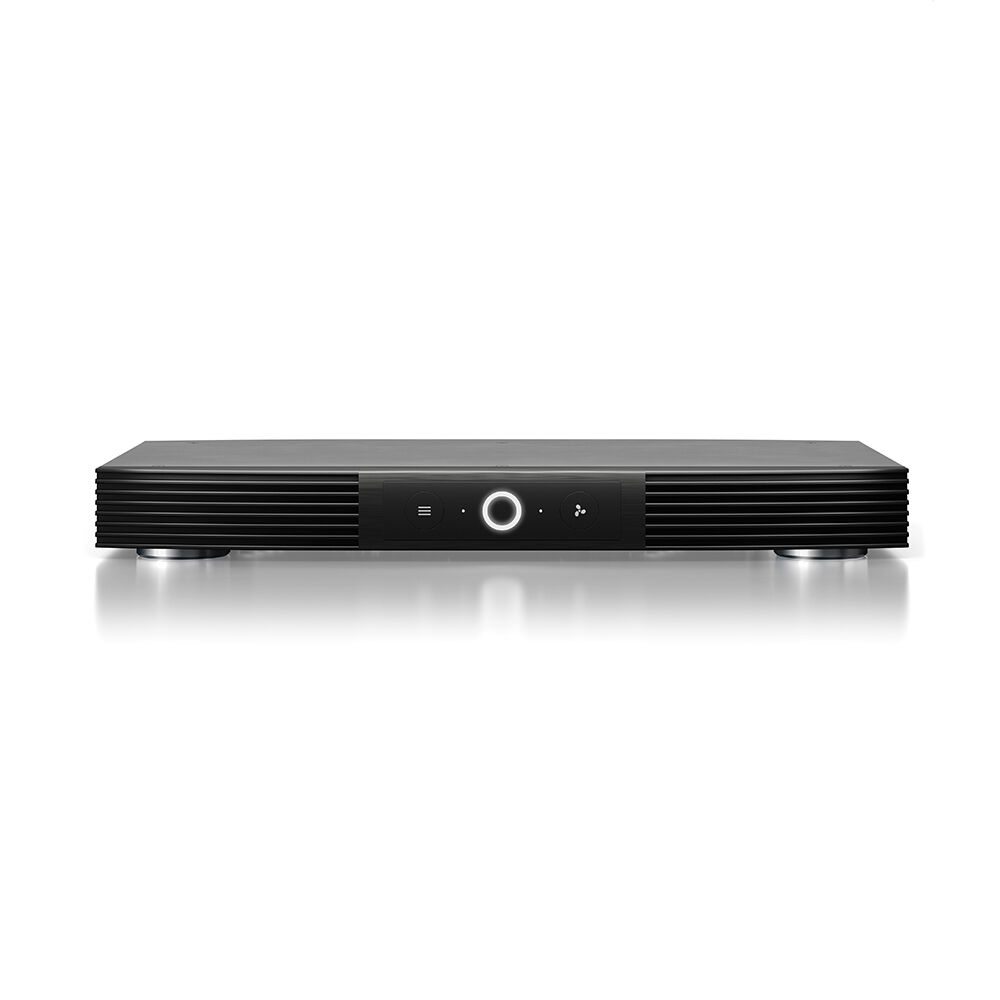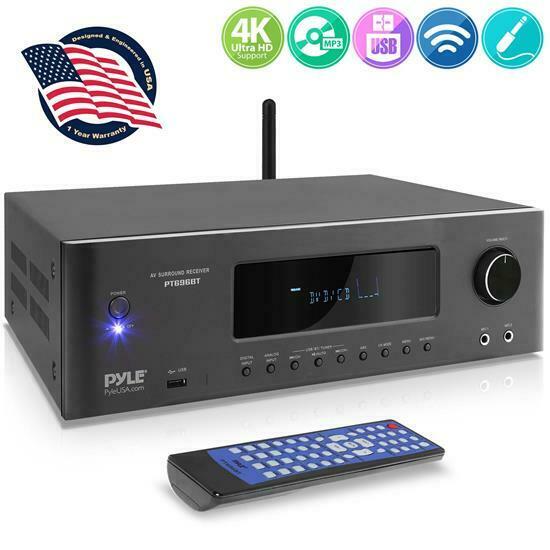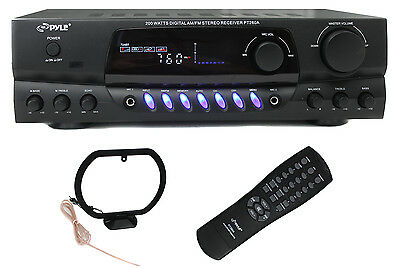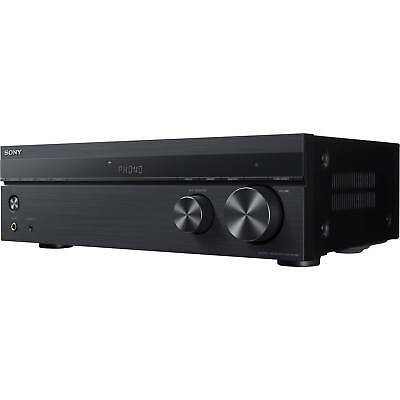-40%
Yamaha AVENTAGE RX-A1080 7.2-Channel Network A/V Receiver - Used, Good Condition
$ 512.15
- Description
- Size Guide
Description
Yamaha AVENTAGE RX-A1080 7.2-Channel Network A/V Receiver - Used, in Good Condition. Condition is "Used". Shipped with USPS Parcel Select Ground or UPS Ground.Included with item:
Power Cord
Remote Control
Wireless Wi-Fi/Bluetooth Antennas x2
YPAO Sound Optimization Microphone
FM Wire Antenna
AM Loop Antenna
( Following review is taken from HomeCinema Magazine )
Home » Review: Yamaha Aventage RX-A1080 AV receiver
REVIEW: YAMAHA AVENTAGE RX-A1080 AV RECEIVER
December 26, 2018
4.5
/
5
(
231
votes
)
Anyone who comes knocking at Yamaha for a better AV receiver with a better amplifier section will join the Avantage line. The most exciting model is the 1,600-euro Yamaha RX-A1080, a 7.2-channel receiver with many intriguing functions on board. Such as support for wireless rears and subwoofer, and the innovative Surround: AI.
Introduction Yamaha RX-A1080
The great thing about the Avantage series from Yamaha is that it offers something different than the competition. Where Denon and Onkyo bet on more channels with a higher model, Yamaha pushes the reset button, as it were, when the affordable RX series is switched to the premium Avantage line. Instead of adding more and more, the emphasis is on improving basic functionality and adding opportunities for advanced users. That is why this RX-A1080 is put on the market as a 7.1-channel model, for a price of 1,599 euros. That description is a bit misleading, because it is a AV receiver that can also handle 5.1.2 channels and has separate amplified outputs for speakers in a second zone.
Yamaha positions the RX- A1080 as a premium device. And you notice that. The device is well finished, has a lot of connections and of course the MusicCast streaming platform built-in. But new this year, there are two options that are unique to the Japanese brand: MusicCast Surround (allowing you to use wireless speakers for the LFE channel and for the rear speakers) and Surround: AI. A feature that continuously adjusts the surround sound to the content and the room, and that sounds pretty interesting.
Massive powerhouse
Is your living room not that big and are you just looking for a slightly better surround sound with your Netflix streams? Then a receiver under 1,000 euros is probably enough. Not this RX-A1080, because the Avantage range from Yamaha is meant for the serious surround enthusiast. Not necessarily a person with a separate room for a home theater, but at least someone who strives for an experience that is closer to a night out to the cinema. This means, among other things, that you enjoy action films on a sound volume and in an equally dynamic way as in the cinema. To make that possible you need a receiver like this anyway. The RX-A1080 is a ‘serious’ device, something that you quickly discover when you take it out of its box. Like the other Aventage receivers, it has a heavier, more solid casing and a tidy front panel that is nicely finished.
Although the
RX-V685
that we tested a while ago was not badly finished, see We immediately notice the difference when we place the cheaper Yamaha receiver next to this premium model in our test room. Both in the main lines (such as the casing) and in the details (such as the solid aluminum lid that handles most of the buttons and the feet for better decoupling) you can see where the extra price is spent. As always with Yamaha, the device is available in a black or silver version. In contrast to Onkyo and Denon, silver does not mean that the whole device carries that color. The Yamaha design opts for a large flat glass over the entire length, where, among other things, the rear display is hidden. That gives the silver-colored RX-A1080 a distinctive look. It looks a bit different and clever, we think.
The 15-kg RX-A1080 is of course somewhere a relative middle class. The housing and the large transformer put him the necessary weight in the scale. But anyone who wants to go for the ultimate in Yamaha can put his back in jeopardy by dragging the CX-A5200 processor and the massive MX-A5200 power amp to his home cinema. In the
Avantage line
there are also three lower models (the A680, A780 and A880), all of which are also 7.2 models. Yamaha makes it a bit more complicated; the offer feels a bit like overkill.
We asked Yamaha to send the RX-A1080 because this Avantage model is the cheapest with Surround: AI on board and the power supply is heavier. That also translates to a heavy housing that is somewhat higher than the three cheaper Avantage receivers. That extra second zone is also something special. At the back of the RX-A1080 there are nine pairs of loudspeaker terminals, not the seven that you would expect from a 7.2-channel receiver.
Well equipped
The back of the RX-A1080 looks very neat and tidy. And that despite the presence of those nine pairs of loudspeaker terminals and many other ports. As you might expect for this price, you do not actually fall short. Via the HDMI inputs you can connect seven sources and there are three HDMI outputs. Strangely enough, HDMI-out 3 is completely different from output one and two on the other side of the device. If you quickly plug the HDMI cable into your screen, you can easily be mistaken. We sighed for a minute or two because we did not get a picture on our TV set, before we realized that the HDMI cable in this third (and in this case switched off) HDMI output stuck instead of HDMI-out 1. Support for Ultra HD (including HDR10 and Dolby Vision) and HDCP 2.2 is available with every HDMI port.
The RX-A1080 comes with legacy video inputs and a spectacular number of audio inputs, both analogue and digital. With three optical and three coaxial inputs, in addition to seven pairs of analog inputs (one of which is a phono input) you will not easily get into trouble. The RX-A1080 is also equipped with pre-outs, so you can also use the device purely as a processor. You might consider that if you already have a good surround-sound stage or would prefer to have your stereo channels amplified by a separate hi-fi amplifier.
When we open the housing of the RX-A1080, discover we also have a very well-stocked chassis. A main role is reserved for the power supply, which consists of, among other things, a large toroidal transformer, cooled by two massive cooling fans. The whole video switching and DSP part is also very strong. The RX-A1080 also has smarthome integration and supports Alexa control, a nice extra for those who get it working. In terms of finish you can not say anything other than: “Very neat”. So you see again that this is a premium product.
MusicCast is very flexible
A major asset of Yamaha receivers is MusicCast. This platform gives devices such as the RX-A1080 a lot of streaming options and makes highly flexible multiroom configurations possible. Yamaha has many MusicCast devices, from wireless speakers that can compete with Sonos speakers to stereo systems. What is interesting about MusicCast is that it does not only focus on streaming services but also on streaming from other sources, including connected physical sources. For example, you can play a CD or send music from Airplay to the A1080 from your iPad and hear that same stream in another room on wireless speakers. Recently, the brand even introduced a turntable with MusicCast. You can for example put this VINYL500 in the dining room with two wireless speakers. If you move to the living room after dinner, you can use the MusicCast app to play the album that plays via the A1080.
When it comes to streaming, the RX-A1080 comes with all the functions of MusicCast: Spotify Connect, Bluetooth, embedded support for Tidal, Qobuz and Deezer, Airplay and internet radio. An upgrade to Airplay 2 is not yet scheduled. You play your own files from a DLNA media server or USB storage that you can plug into the front USB port. The MusicCast app (iOS and Android) also makes it very simple to send files that are on your mobile device to the receiver. Given the many possibilities, it will not surprise you to use the MusicCast app much more easily on a tablet than a smartphone.
A nice extra that we always appreciate at Yamaha receivers is that Bluetooth working in two directions. So you can not only stream music from your smartphone to the receiver, you can also send music from any source to a Bluetooth headset or speaker. It is mainly a headphone scenario that we find interesting, because in the late evening you can play a noisy movie or game wirelessly.
A peculiarity is that we only use part of the DNLA via the MusicCast app. to see servers on our network. For example, the MinimServer running on our Synology does not appear in the overview. Through BubbleUPnP we can easily access that server and send music to the RX-A1080. Crazy, but can be on our complex network. In any case, the receiver passes our format test with gloss. The RX-A1080 plays most formats, including DSD and exotics as hi-res WAV and AIFF. Unfortunately, multichannel FLAC, ALAC and WAV do not work. That is the case with most AV receivers; only our Oppo and Panasonic UHD players do.
MusicCast is not the only app Yamaha offers to operate the receiver. There is also AV Controller, an app that replaces the remote and contains a surprising number of options. It is a bit messy but nevertheless very convenient. For example, to further adjust the DSP modes (via a visual interface or to quickly control the (with speaker cable connected zones)
Measuring once or more?
The RX-A1080 Setting up is relatively smooth Although you do not have a user-friendly setup assistant such as Denon and Marantz, Yamaha has provided an alternative in the form of a separate app. We already wrote it in our review of the RX-V685 (a receiver from the same generation as this unit): Yamaha has cleaned up and made the TV interface of AV receivers a bit tidier, which was necessary because the emphasis was very much on offering a large number of options – but you could lose in the many choices, that’s better now, not because many options have been deleted, but because something more order seems to have been put in. It’s still really Yamaha, with menu backgrounds with photos of instruments and a menu structure that does something to a classic PC interface. Not very flashy, but as we said it is neater than before.
The TV interface of the RX-A1080 looks great on an Ultra HD screen (although we naturally continue to argue for an interface in a native 4K resolution) . If you feel comfortable with the extensive menus, you will discover many options for tweaking and optimizing your surround set with the Yamaha RX-A1080. It is a completely different experience than, for example, the
Onkyo TX-RZ830
where a very limited interface is chosen that stays completely to-the-point.
Yamaha uses YPAO system to measure the position of your speakers and the room properties. With the included microphone you measure from one listening position. That takes a bit longer than normal, but unlike Dirac or Audyssey you do not have to move the microphone continuously. If you want to work more accurately, then you have the option to perform additional measurements on the RX-A1080. They last less than the first. Actually there is no reason not to do them, we think.
Even with one measurement YPAO delivers good results. The distances to the speakers are correctly estimated, although we do not fully agree with the levels that are chosen. But no problem, you can easily change it via the interface. Small criticism: why can not you adjust the volume per speaker while a test tone is playing? Characteristic of Yamaha is that these two things (volume adjustment and a test tone) are a separate choice.
The extensive possibilities that are still somewhat complex will be redundant and perhaps even confusing for some. But if you (like us) like to tweak, then you will find at Yamaha some possibilities that are missing elsewhere. For example, you can adjust the many DSP modes individually to different variables, just to say something. Of course, this is all not unique for the Avantage line. Also the cheaper RX receivers have largely the same options.
The YPAO measurement is not as final as it seems at first, because you can dive into the settings and choose from different YPOA equalizers. There is also a YPAO Volume setting that has a big influence on the sound. When listening to music we thought it was appropriate to turn it off. When you consider that you can adjust so much, it is really strange that you do not get the level of control that you have with Dirac (Arcam and NAD) or the Audyssey MultEQ app (Marantz and Denon). Take care of that, Yamaha, and we are completely happy.
Rear channels without wires
Many people stay away from AV receivers and surround setups because a lot of cables are involved. And that’s a shame, because even a good soundbar can not easily match a real 5.1 system. Let alone a surround system with even more speakers … If you ask people who reject AV receivers, the problem seems to be mainly with the rear channels. It is the cables to those speakers that are the hardest to get rid of nicely. What Yamaha offers with its new receivers is therefore very interesting: wireless rear-speakers. It is something that we had expected much earlier, especially with Denon and Marantz. Their HEOS platform can, as the
HEOS AVR
already demonstrated, but the functionality has not yet been implemented in their mainstream receivers. Yamaha does – and even goes a lot further. The function, called MusicCast Surround, is ready to make the rear channels wireless and the subwoofer. Then there are some cables less, although the wireless speakers from Yamaha each have a power cable. But we assume that it is easier to find an outlet behind your seat than a speaker cable or two through the room.
For a surround setup with wireless components, you should work with MusicCast- speakers (the MusicCast 20 or 50, other models do not work) and possibly MusicCast Sub 100. For our test we went to work with two MusicCast 20 speakers. Connecting them to the receiver is relatively quick. First you have to pair the receiver and possibly the speakers with the MusicCast app, which is equivalent to holding down a Connect button for five seconds. If you connect the devices with ethernet cables to your network, then it will be done very quickly, if you choose WiFi (which is logical for the rear channels) then you have to carry out a short step-by-step plan. You then add the receiver and the speakers to a room and give them a picture of their own. Then you dive into the settings of the app and create a Surround setup by dragging the two speakers on the receiver. It is not very difficult. But, as we noticed when setting up, you also need to set a 5.1 setup on the receiver in the setup. That makes sense, but because the interface of the RX-A1080 is focused on wired speakers and does not mention wireless speakers, you can still doubt. You might also wonder if you could, for example, use two MusicCast speakers to bring your 5.1 setup to 7.2? That would have been nice, but alas … 5.1 is the only possible setup.
Of course you do not necessarily have to invest 1,600 euros in a receiver like this one to get wireless rears. MusicCast Surround also works on the cheaper RX line, such as the RX-V685. And that makes sense, because wireless rear-speakers seem to us something for people who want to surround themselves in a modest way. But we do not complain about the RX-A1080.
Wireless speakers: surprisingly good
For the test we connected the Yamaha RX-A1080 with our fixed surround setup, consisting of Dali Rubicon LCRs and a Rubicon Vokal . The subwoofer is our faithful Monitor Audio Silver W12. The rear speakers are alternately a set of Boston Acoustics M25 and the MusicCast 20 speakers. We simply place the latter on the windowsill left and right behind our seat. Let’s talk about the setup with the wireless speakers first. We have already used the MusicCast 20 speakers for the VINYL500 turntable test, and we know which meat we get in the tub. The MusicCast 20 speakers are in any case much better speakers than the first MusicCast speakers. Now these well-finished loudspeakers are quite comparable in terms of performance to a SONOS One.
Maybe it’s because of the comparison with the SONOS speakers that we did not really know what to expect from two MusicCast 20 speakers as rear surround channels. If you combine a SONOS Playbar with two One’s, you get something that looks like surround. But it is not exactly that convincing, it is more of a mood maker. What you get from a MusicCast Surround setup with two MusicCast 20 speakers is something different. It is really the correct surround information that is sent to the two speakers. The hectic racing scenes from ‘Ready Player One’ (Ultra HD Blu-ray, Dolby Atmos) do not really make a difference between the wired speakers and the MusicCast speakers in terms of timing. What we feared – lag or delay on the rean channels – does not seem to be there. We sometimes notice that the audio stream to one or both MusicCast speakers is very short. It is especially noticeable when we stand close to the speakers and listen very carefully. Really micro interruptions, which do not stand out when watching movies.
However, we had to raise the volume level of the MusicCast 20 speakers to better match the speakers with the wired front speakers. That makes us suspect that you should not be too far away from the MusicCast speakers. Yet something for a normal living room, but that’s right. MusicCast Surround is a comfort solution, a surround enthusiast with its own cinema room will still opt for wired speakers. As we also notice when we review the same RPO scenes with the Boston speakers, a decent bookshelf speaker can show a fuller, detailed sound. And yet, through Ready Player One – for example when Parzival and Art3mis go to a nightclub – we are nevertheless impressed by how spatial the surround experience is with the two MusicCast 20 speakers. We also notice that the Surround: AI function offers real added value in this setup. It is best to switch on.
The smart receiver
The Surround: AI function is what we focus on during the testing, but then with all the loudspeakers wired to closed. Explaining what the function does is not easy, partly because Yamaha keeps it vague. In essence, it is an algorithm that continuously analyzes the soundtrack and adjusts its display accordingly. That is a step further than a room measurement, which adjusts the sound in function of your room. Surround: AI does indeed take space into account, the YPAO measurement also takes care of that, but also involves what you view and listen to. It continuously adjusts the sound to always sound optimal – whether you’re looking at a silent scene with dialogues or an action-packed part of a Transformer movie. If Surround: AI is on, you will see a light on the front of the receiver light up. If desired, you can display an indicator on the screen indicating what the AI emphasizes (for example in the front of the room, if there are many dialogues).
The battle for Camelot in the first ten minutes The cool ‘King Arthur’ by Guy Richie (Ultra HD Blu-ray, Dolby TrueHD 7.1) is perfect for discovering what the AI function does. To begin with, it is good to know that the function does not work in Pure Direct mode. Logical, because this is a complex DSP mode. If you choose Surround: AI, then you can not switch to the many known DSP modes that Yamaha always offers. We sometimes find these things superfluous (simulating a beer cellar in Munich … why right?), But their presence does no harm. What does the new AI function offer now? During the storming of the castle by a mass of baddies and three very gigantic elephants, Surround: AI gives a much more massive, fuller sound. The fine detail disappears, in favor of a much more immersive experience. In looking further at the film, but also at ‘Ready Player One’ and ‘The Justice League’ (Ultra HD Blu-ray, DTS: X) we are inclined to keep switching between Surround: AI on and off. It is really a matter of taste, but in the end we keep the function active because it makes films look a bit more impressive. It also succeeds in maintaining the surround experience when the volume is lower, which makes us think that the AI does some compression where necessary. That makes Surround: AI on paper comparable to Audyssey Dynamic EQ and Dynamic Volume with Denon and Marantz, but it is different. You notice that it does indeed act more actively when changing scenes and at peak moments in the soundtrack than at others. However, it is interesting to ask whether you would upgrade to the RX-A1080 or an even higher Yamaha from a recent receiver. Just for Surround: AI we would not recommend that, but it is a (perhaps decisive) argument if you were looking for a receiver in this segment.
In this price range you also want a receiver that you put music nicely. As already mentioned, thanks to MusicCast, the RX-A1080 already has many assets when it comes to music streaming. It is a question of taste whether you would like to listen to your stereo-recorded music as planned or have the receiver send to all speakers. As usual you have different options for it (like 7-channel stereo or DTS: Neural X), but also Surround: AI. But how impressed we were of this function for film, for music we found it really too artificial. Still rather in stereo. If you want to listen to music via the L and R speakers, you can connect those two speakers bi-amp (so with a double speaker cable per speaker). The RX-A1080 has a SABER 9007S Pro-DAC (a higher chip from ESS) so you do not have to worry too much about the DA conversion. When listening to music we could not really catch the Yamaha receiver on anything bad, although we would definitely recommend turning off those YPAO Volume and Surround: AI functions. Even with an album like Wu-Tang Clan’s ‘The Sage Continues’ (Qobuz, CD quality) they were too much of a good thing, while hip-hop is often better with a somewhat heavy, compressed sound. Overall, the RX-A1080 is a good music player, with a more mature, better sound than, say, the RX-V685. Personally, in this area we find both the Arcam AVR-550/850 and the Marantz SR8012 the devices to beat. Yamaha does not do that with this receiver – a subjective opinion, admittedly. That the receivers cost much more than the RX-A1080 is an objective fact.
Conclusion
The RX-A1080 is a device that shows convincingly why you would invest more in an AV receiver. It offers more possibilities, but above all is much better able to display movie soundtracks in their full glory. It is a powerful device that presents movie soundtracks very powerful and enveloping. Music also puts it nicely down, thanks to the solid ESS-DAC and amplification. Although the (much more expensive)
Marantz SR8012
remains the gold standard for us.
The Yamaha RX-A1080 is also very innovative. Now you see more often at AV receivers a laundry list of functions popping up, useful or not. But both MusicCast Surround and Surround: AI are really valuable additions to a receiver that is already full of powerful options. A slightly steeper learning curve is part of that, yet if you want to make the most of it. Add to that the great MusicCast platform and you talk about an AV receiver that deserves the label ‘very good’ undoubtedly.
Cons
YPAO tweaking for expert learners would be welcome
Wireless speakers not usable for non-5.1
Still somewhat more complex in terms of operation
Pros
Wireless rears speakers are convenient and effective
Lots of power, even for bi-ampene stereo channels
MusicCast platform
Surround: AI and DSP modes
DAB +











